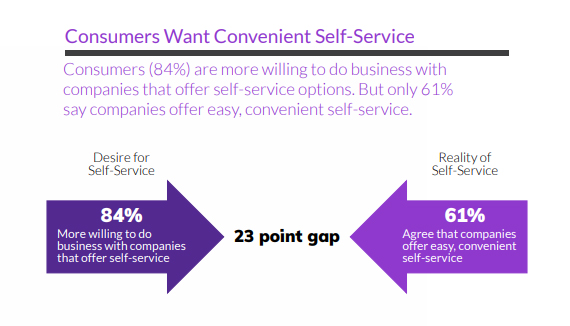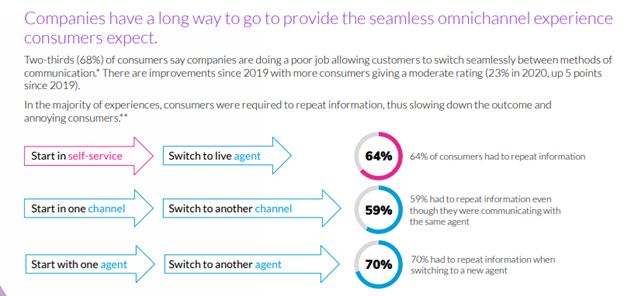In today's fast-paced digital world, consumers expect speed and convenience when interacting with a business—and proactive customer service checks both boxes.
We've all grown used to the proactive notifications online retailers send about deliveries and the ones airlines provide about flight statuses. These notifications aren't just "nice-to-haves." Personally, they have saved me from spending unnecessary time in airports and prevented packages from being stolen from my doorstep by porch pirates.
Conditioned by industry-leading retailers, airlines, and other businesses, people now expect companies to understand, anticipate, and address their needs. Organizations that do this can improve customer satisfaction and boost their brand image. According to one study, "89% of consumers found proactive customer service to be a pleasant surprise or a positive experience." Additionally, "92% of consumers reported that the experience of being contacted proactively by the company changed their perception of the company in a positive way."[i]
Outbound notifications aren't the only way to provide proactive customer service. Modern technology has enabled capabilities such as virtual agents that help people navigate friction in specific parts of the customer journey, and AI-powered analytics that allow contact center leaders to stop emerging issues in their tracks.
Quickly solving problems after the customer calls a contact center is a reactive approach that may not meet some customers' expectations. To increase customer satisfaction, businesses need to be proactive in how they deliver customer service. Not only will this approach make customers happier, but it can also increase loyalty and overall business results.
Related resource: “Cheat Sheet for Customer Loyalty”
What is proactive customer service?
Proactive customer service means anticipating customers' needs and reaching out to them about problems before they contact customer service. Sometimes this can be done before the customer even knows they have a question or issue. Proactive customer service can also mean making improvements to service experiences in anticipation of customer demands.
Providing proactive customer service requires a deep understanding of customers and customer journeys. Businesses need to be able to predict customer behavior and know what portions of the customer journey may cause confusion or other friction. This knowledge enables businesses to proactively address issues at the right time and place and guide customers through transactions.
Examples of proactive vs reactive customer service
One of our clients, a large healthcare provider, is a good example of an organization that provides proactive customer service. If you needed medical services during the height of the COVID-19 restrictions, you know how confusing the different rules were. Do I need to wear a mask? Do I need to be fully vaccinated? Do I need to have been recently tested? Can I bring another person to my procedure?
Recognizing the potential confusion, this client used our outbound dialer to text COVID instructions to patients ahead of their appointments, and if the carrier indicated the number the dialer called was a landline, someone would call the patient to provide the instructions.
I can imagine knowing this information reduced patient anxiety and also ensured many more people showed up to their appointments prepared.
Compare this to a reactive approach in which a provider relied on patients to check their website for COVID instructions rather than proactively notifying them. This approach:
- Creates more work for patients
- Increases anxiety
- Increases the likelihood that people show up to appointments unprepared, requiring them to reschedule
In many cases, reactive customer service is a necessity, but organizations should take a more proactive approach when possible. As this example illustrates, it provides a much better customer experience.
Why does speed matter? Is proactive the new standard?
Speed has always been an important factor in customer service. That's why contact centers focus so much time and energy on keeping wait times at an acceptable level. Customers get irritated and impatient when they have to wait for help. But is the demand for speed increasing?
A recent Salesforce study found that “Eighty-three percent of customers now expect immediate engagement when they contact a company.”[ii] That was a five-point increase from the prior year, so it appears that the need for speed is increasing.
Modern consumers want instant gratification in everything they do, including their customer service experiences. But as more and more businesses become able to meet this expectation, it's no longer as effective as a competitive differentiator. It's likely that proactive customer service will become the next thing that distinguishes exceptional CX from average CX. Proactive customer service is kind of like traveling at the speed of light, and you can't get much faster than that!
Ideas for proactive contact center CX
Contact centers should do everything they can to be proactive about the customer service they provide. Not only will it increase customer satisfaction, but it also decreases interaction volume. The following are some ways organizations can leverage their knowledge of customer needs to deliver proactive support.
Smart, effective self-service
Proactive customer service is all about anticipating and fulfilling customer needs, and most customers need (and want) effective self-service options. According to one study, 81% of consumers try to handle matters themselves before contacting a live customer service agent.
Gartner found that 70% of resolution journeys include self-service, however, only 9% are fully contained in self-service solutions.[iii] In other words, customers are trying to solve their own issues, but they're not always successful.
Self-service can be a competitive differentiator if it's done right. Our research found that eight in ten consumers are more willing to do business with companies that offer self-service options, yet only 61% agree that companies are offering easy, convenient self-service.[iv]
Where should businesses focus if they want to do self-service "right?" Implementing a smart knowledge base is a great place to start. According to Forrester, self-service is increasingly used as the first point of contact by customers within customer service organizations. The more positive these self-service experiences are, the more satisfied and engaged customers feel.[v]
The right knowledge management system provides customers with the most relevant answers rather than a confusing laundry list of unrelated topics. Additionally, it can extend to search engine results, so customers get answers more quickly. That's proactive!
AI-powered virtual agents can also provide proactive self-service. These conversational smart bots understand human language, which allows customers to speak naturally to resolve a wide variety of tasks. Additionally, machine learning enables virtual agents to get smarter with time. As an example of proactive customer service, virtual agents can learn what follow-up questions customers typically ask after the initial question and provide the answers before the customer even asks. Businesses can also use virtual agents proactively by placing them strategically at points in the customer journey where customers might hesitate or experience confusion.
Effective self-service can be faster and more convenient than agent-assisted channels and it's available 24/7. These qualities enable the instant gratification customers expect and value.
Omnichannel experiences
Omnichannel may sound like a reactive solution, but when you consider that 68% of consumers say companies are doing a poor job allowing customers to switch seamlessly between methods of communication,[vi] I would say executing true omnichannel is a way to be proactive. Plus, since 96% of consumers expect omnichannel,[vii] it's a good way to meet expectations and differentiate the quality of your support.
Why is omnichannel so important to consumers? Salesforce found that 74% of consumers report having used multiple channels to begin and complete transactions. And when they do this with businesses that don't provide omnichannel support, they need to repeat information, sometimes multiple times. Not only is this an annoyance, but it can make customers question whether the business really knows them.
Omnichannel is the way to go for seamless, lower-effort customer service experiences.
Proactive problem management
Strong problem management capabilities enable contact centers to provide proactive customer service by stopping new issues before they have a chance to leave the starting block. Quickly addressing emerging problems ensures a minimal number of customers are impacted, which improves CX and helps businesses avoid additional volume.
When they have an effective way to listen to customers, contact centers are often the first to know about product defects, broken website functionality, and other customer-impacting issues. The best way to listen is with AI analytics.
AI-powered interaction analytics analyzes all customer service interactions (voice and text) from all channels in real-time and can find patterns to extract timely insights such as:
- Customer sentiment
- Contact drivers
- Trending topics
- Root causes
On the front end of the problem management cycle, interaction analytics can act as an early warning system. On the back end, it enables contact center leaders to determine if fixes are working.
Give agents a leg up with their soft skills
Proactive customer service can mean leveraging new technology to improve CX. Real-time interaction guidance software is an example of advanced modern technology that helps agents provide the type of personal connections customers want.
According to one study, 57% of consumers say they would increase spending with a brand if they feel connected to it. Further, 77% would choose to purchase from that brand over a competitor.[viii]
A customer's feeling of connection with a brand is largely based on emotion. An agent needs strong human skills to make the type of personal connections with customers that builds loyalty. Not all agents are naturally empathetic or have already developed great active listening skills, but these and other soft skills can be learned.
Onboarding and ongoing training should have a heavy focus on soft skills, but skill-building shouldn't be confined to the classroom, and it doesn't need to be only a periodic lesson. Real-time interaction guidance tools can coach agents in the moment every time they speak with a customer.
This tool uses artificial intelligence to determine customer sentiment and uses that as the basis to coach agents on soft skills proven to enhance the interaction and customer satisfaction. For example, if the agent and customer keep interrupting each other, this real-time tech will remind the agent to use his active listening skills.
Consistent, unbiased coaching helps agents continuously improve their engagement skills and provide a better experience to the customers they serve. Learn more in the Aberdeen report, "The ROI of Real-Time Agent Guidance."
Close the loop on customer feedback
Here’s a pro tip: Customers will think a business is proactive if they receive a call or email about feedback they provided.
Filling out a customer survey or complaining to a contact center agent can feel like you're sending your opinion into a black hole. How many times have you heard from a business after providing negative feedback on a survey? Feeling like your input isn't heard or acknowledged can damage relationships.
CX-focused businesses close the loop on negative feedback by contacting disgruntled customers to try to make things right. This approach can turn things around and even strengthen relationships, but a closed-loop process doesn't only need to target detractors. Highly satisfied customers can be contacted to thank them for their positive feedback and encourage them to become brand promoters.
The benefits of proactive customer service
Proactive customer service can significantly reduce interaction volume and the associated costs. But perhaps the more important benefit is the impact it has on customer perceptions.
- Nearly 70 percent of customers favorably view brands that engage in proactive customer service[ix]
- 67% of global consumers find proactive customer service notifications favorable[x]
- Proactive customer service results in a full point increase in Net Promoter Score (NPS), Customer Satisfaction Score (CSAT), Customer Effort Score (CES), and Value Enhancement Score (VES)[xi]
Providing proactive customer service is worth the effort. It lifts customer satisfaction, brand advocacy, and overall CX while also creating operational efficiency. Yet Gartner research found that only 13% of consumers reported ever receiving any type of proactive customer service.[xii] This is a clear opportunity for businesses to differentiate themselves.
Reactivity is a common pitfall every contact center should avoid. Learn how to avoid and overcome other perilous pitfalls by downloading "The Top 5 CX Pitfalls! And how to overcome them." We think you’ll get a kick out of the fun '80s gaming vibe.
[i] Helplama: Why Do Companies Need To Be Proactive in Customer Service [Survey] (2021)
[ii] Salesforce: What Is Customer Engagement? Key Findings from Global Research To Help Your Business Grow (2020)
[iii] Gartner: Does Your Digital Customer Service Strategy Deliver? (2019)
[iv] NICE CXone: 2020 Customer Experience (CX) Transformation Benchmark, Consumer Wave (2020)
[v] Forrester: How To Modernize Digital Customer Self-Service (2019)
[vi] NICE CXone: 2020 Customer Experience (CX) Transformation Benchmark, Consumer Wave (2020)
[vii] NICE CXone: 2020 Customer Experience (CX) Transformation Benchmark, Consumer Wave (2020)
[viii] Sprout Social: #BrandsGetReal: What consumers want from brands in a divided society (2021)
[ix] Microsoft: The global state of customer service (2019)
[x] Microsoft: Global State of Customer Service: The transformation of customer service from 2015 to present day (2020)
[xi] Gartner: Press Release: Gartner Says Organizations Need to Move from a Reactive to Proactive Customer Service Approach (2020)
[xii] Gartner: Press Release: Gartner Says Organizations Need to Move from a Reactive to Proactive Customer Service Approach (2020)






